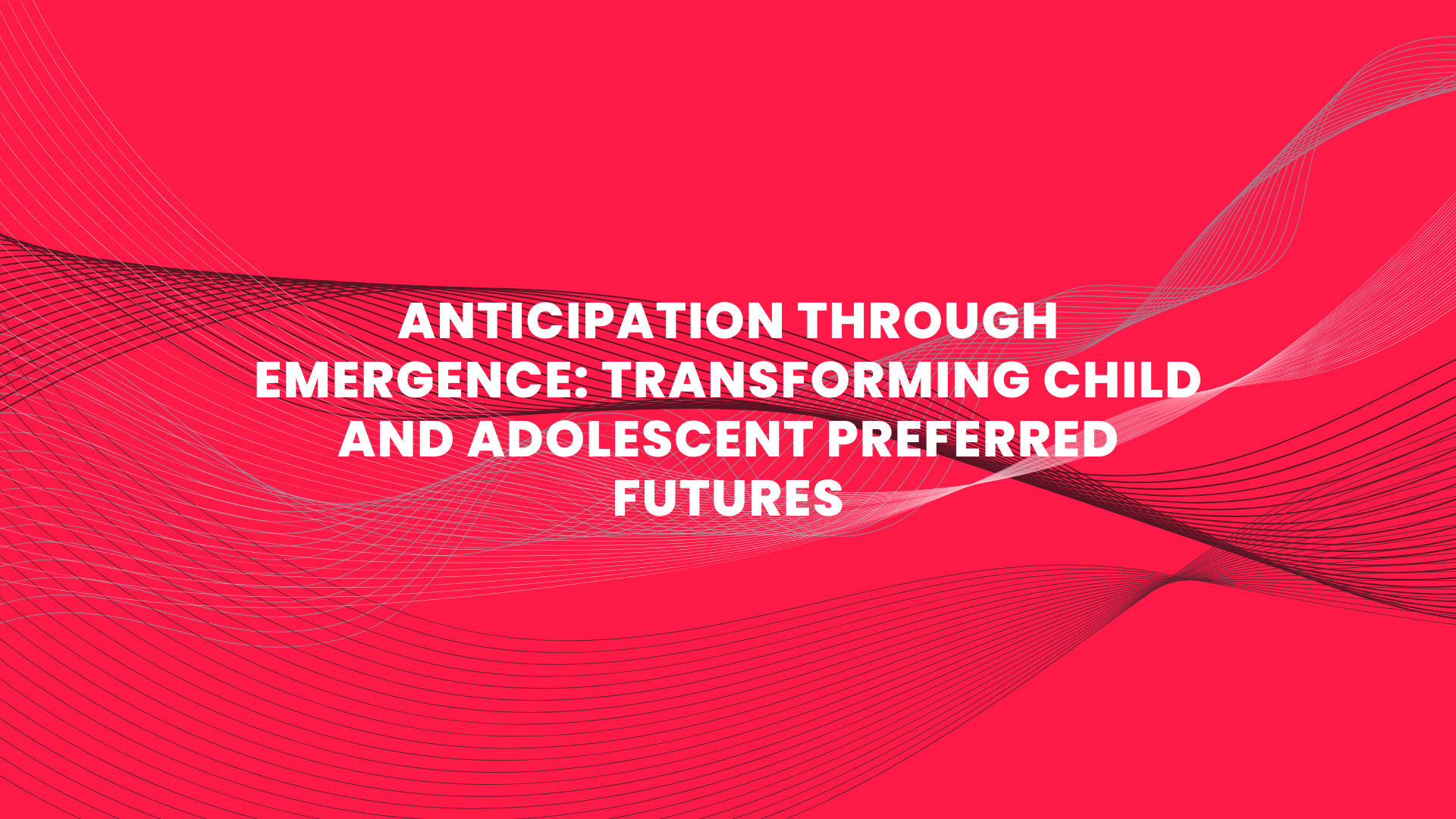
Anticipation through emergence: transforming child and adolescent preferred futures
What is Futures Literacy? What is Futures Thinking? What makes a futures literate person? How can we use the future in different ways? How do we make sense of it or “use the future” to change the conditions of change and transform the way we perceive and imagine child and adolescent futures? What are the products or possible outcomes or potential impacts of Futures Thinking and Literacy on child and adolescent issues and concerns? How can a UNICEF facilitator build a futures-driven skillset and use anticipatory ideas, systems, and processes to increase UNICEF stakeholders’ and partners’ capacity to use the future to innovate today?
From a policy and community development perspective, what might the futures of HIV treatment and services, adolescent engagement in governance, and inclusive education access look like in the year 2030? What are the trends, the emerging issues, and drivers of child futures at the local and global levels? How might it look and feel like for a child to live in an alternative future world where every child is free and protected from cyber abuse and exploitation? What might a day in the life of a child be like in a world where every child can express themselves, develop their full potential and capacity, and become active change agents of civil societies and communities? How can we better engage parents and families in reproductive health and create a stronger support system in the protection of the child from cyber world and physical and verbal abuse? Are UNICEF trainers and facilitators optimistic or pessimistic about their power and capacity to influence the future?
These are some of the ideas, topics, and questions that participating UNICEF trainers and facilitators collaboratively questioned, debated, and explored through the futures thinking and futures literacy workshop organized by UNICEF and facilitated by the Center for Engaged Foresight, a premier strategic foresight and futures literacy hub in the Philippines and the Asia Pacific. Around 25 UNICEF trainers and facilitators participated in the 2.5 days workshop held on November 22-25, 2018, at the Marco Polo Hotel in Pasig City Philippines.
The workshop was designed to introduce Futures thinking and train UNICEF facilitators to become Futures literate.
This workshop aimed to provide an open and safe space for UNICEF trainers and facilitators to survey and align diverse hopes, interests, and perceptions about the future by learning Futures thinking and developing Futures literacy skills. The imperative of this workshop was not to fix or resolve a specific policy issue or to engineer a new solution but rather to elucidate the value of Futures literacy and foresight in child protection and adolescent development. The project sought to engage participants in a collective reflection and spurred their creativity in the difficult task of questioning used and default futures, reframing and reflecting on the future of the child in a world driven by emerging technologies, the cyberspace, social networks, family, multiple identities, climate change, etc.

Integrating Futures Thinking and Futures Literacy
Learning the importance of context and knowing how to use anticipatory systems and processes in different ways makes a futures literate person. The participants organized into groups and explored the futures of the following topics:
- Youth engagement and participation in governance
- Access HIV/AIDS education, prevention, treatment, and management
- Cyber Child Protection Policy
- Reproductive Health Implementation in the Philippines
- Inclusive and Equitable Access to Education in the Philippines
The UNICEF workshop integrates five of the six pillars of Futures thinking with UNESCO’s futures literacy process:
Reveal. To question and reveal participants’ contexts and assumptions about the future and that of their chosen topics, mapping tools such as futures in motion, the Polak game, shared history, and futures triangle futures techniques were applied.
Rethink and Reframe. To learn how to rethink and reframe ways of knowing and perceiving futures and learn the value of imagination in the creation of alternatives and preferred futures – anticipating, creating alternatives, and deepening futures techniques were used: emerging issues analysis, the thing from the future game, STEEEP analysis, double variable scenario method, storytelling and prototype construction.
Reflect and Consolidate. This focused on participants reflecting on the process, their transformed futures, and aligning the same with one’s personal values or future visions including capturing what was learned, what might work or not, some tips on futures facilitation, and more importantly participants’ thoughts, ideas, feedback, comments and experiences about the workshop and futures literacy as a system or a process, as a concept or as a tool to trigger and manage social transformation. Possible next steps were explored. To do this, creative visualization techniques and questions such as what is the overall feeling? what were the lessons learned? what are the key takeaways? and what are the possible next steps? were asked in a brainstorming, feedback, and Q&A session.

Anticipation through emergence: transforming child and adolescent preferred futures
Having been able to draw out four scenarios, the groups were then asked to choose their preferred future of the issue they had been working on. They were then given boxes of materials, colored papers, paper cups and plates, popsicle sticks, scissors, tape, paste, magazines, and other art materials to make a prototype of their preferred future. The groups were asked to make the prototype as vivid a representation of their preferred future as possible. They were asked to give a title for their prototype and can answer questions about it. By doing the prototype, the participants could have a tangible representation of the future they want and are working on achieving.
Building prototypes enable participants to demonstrate, test, and refine their alternative future worlds and encourages invention with a purpose in mind. It allows participants to provide more details about their stories of for instance a day in the life of a child in alternative future environments (i.e. the future of HIV or anti-child pornography in the Philippines). It makes more vivid or visual the stories of alternative futures that participants create. Building prototypes bring workshop participants’ alternative and preferred futures to life. It helps them to go beyond preconceived notions of the future and explore alternatives as much and as deeply as they can.
The participants presented in plenary through the lively and creative narration of their transformed futures prototypes: 1) The Peak – In Pursuit of Filipino Excellence and Well Being One Step at a Time; 2) Fantasia Our Reality – Zero Stigma, Zero New Cases, Zero deaths in the Philippines; 3) The Village of Clouds (Barangay Langit) – A Safe Haven for Kids; 4) Pangarap kong Bayan (The Town that I Dream Of) and 5) Freddy’s Dioaramic Future. The scenario narratives will be shared by UNICEF in a publication this year. A UNICEF futures literacy toolkit and the comprehensive final report will be shared with to target audience and participants.

Overall feeling? Lessons learned? What we take with us? Next Steps?
For the final synthesis, UNICEF facilitators were asked to share the lessons they have learned, and insights gained in the plenary. All the participants expressed appreciation for the experiences, insights, learning, and new tools they gained within the two-and-a-half-day workshop. Most agreed that their expectations like “enrichment”, “development” and “fun learning activity” have all been met and expressed their desire to apply and share this new capacity and skillset acquired.
Using the future requires the understanding and application of a spectrum of Futures literacies. Like history where we focus the study or analysis of the origins and implications of the past to the present, futures literacy increases our competency and capacity to anticipate possible and unfamiliar futures and study which does not exist yet. Futures literacy uses images (imagined or real), values (contexts and experiences), and meanings (the way we interpret stories and data and reframe things, policies, and stuff for instance) including using a wide range of tools to learn the capacity to explore, negotiate and create alternative future worlds, preferred futures and anticipate emergence.
This futures literacy workshop is a learning journey. Through the futures literacy lab, participants learned how to facilitate a futures literacy workshop and learned how to use the future to improvise, experiment, and innovate in the present. And through the pillars of Futures thinking, they learned how to use and blend different ways of learning and futures facilitation —creative, critical, interpretive, action-learning, intuitive, games, and evidence-outcome based approaches – to create alternatives, identify and transform preferred futures. While they learned new knowledge and gained a new skillset, the participants felt a renewed sense of commitment to their advocacies and to social transformation. This workshop according to them also kept their desires for change alive. That it radically changed their perception, perspectives, and ways of knowing the future. They also acknowledged the value of anticipation in decision-making, policy analysis, and strategy development. They realized the beauty and worth of imagination and self-awareness in building a better world for all of us.
UNICEF training partners were asked to share the knowledge that they gained and test the toolkit and lessons learned that will be shared after. They were encouraged to apply the toolkit creatively and whenever possible customize or localize it to suit the needs and contexts of their respective stakeholders. Participants were urged to be creative in facilitating their sessions, to document their experiences and insights, and report back the lessons learned to UNICEF to improve the design of Futures literacy labs at the community level. The effort to utilize the future in child and adolescent issues is a work in progress. Everyone was excited and see this endeavor as an adventure to create better and brighter futures for all especially children and adolescents.
